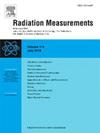Detection of beta-emitting radioactive hotspots inside the Fukushima Daiichi Nuclear Power Station Unit 3 reactor building using an optical fiber radiation sensor based on wavelength-resolving analysis
IF 2.2
3区 物理与天体物理
Q2 NUCLEAR SCIENCE & TECHNOLOGY
引用次数: 0
Abstract
We measured the distribution of beta-ray emitters inside the Fukushima Daiichi Nuclear Power Station Unit 3 reactor building using a novel optical fiber-based position-sensitive radiation sensor designed for operation in high dose rate environments. Plastic scintillation fibers (PSFs) were installed inside the Unit 3 reactor building, where scintillation light generated through interactions between radiation and the PSFs was detected by a spectrometer to obtain the wavelength spectrum. By applying an unfolding method to the wavelength spectrum, we estimated the distribution of beta ray emitters along the PSFs. To isolate the beta ray contribution in a high gamma dose rate field, we compared measurements taken with and without a stainless steel tube serving as a beta ray shield. As a result, we identified a hotspot predominantly influenced by beta rays for the first time in the high dose rate area on the southern side of the first floor of the Unit 3 reactor building.
利用基于波长分辨分析的光纤辐射传感器探测福岛第一核电站3号反应堆建筑内的β辐射热点
我们使用一种新型的基于光纤的位置敏感辐射传感器测量了福岛第一核电站3号反应堆建筑内β射线发射器的分布,该传感器专为在高剂量率环境下运行而设计。3号反应堆建筑内安装了塑料闪烁光纤(psf),通过光谱仪检测辐射与psf相互作用产生的闪烁光,获得波长谱。通过对波长光谱的展开方法,我们估计了沿psf的β射线发射器的分布。为了隔离高伽马剂量率场中β射线的贡献,我们比较了使用和不使用不锈钢管作为β射线屏蔽的测量结果。结果,我们首次在3号机组反应堆建筑一楼南侧的高剂量率区域确定了一个主要受β射线影响的热点。
本文章由计算机程序翻译,如有差异,请以英文原文为准。
求助全文
约1分钟内获得全文
求助全文
来源期刊

Radiation Measurements
工程技术-核科学技术
CiteScore
4.10
自引率
20.00%
发文量
116
审稿时长
48 days
期刊介绍:
The journal seeks to publish papers that present advances in the following areas: spontaneous and stimulated luminescence (including scintillating materials, thermoluminescence, and optically stimulated luminescence); electron spin resonance of natural and synthetic materials; the physics, design and performance of radiation measurements (including computational modelling such as electronic transport simulations); the novel basic aspects of radiation measurement in medical physics. Studies of energy-transfer phenomena, track physics and microdosimetry are also of interest to the journal.
Applications relevant to the journal, particularly where they present novel detection techniques, novel analytical approaches or novel materials, include: personal dosimetry (including dosimetric quantities, active/electronic and passive monitoring techniques for photon, neutron and charged-particle exposures); environmental dosimetry (including methodological advances and predictive models related to radon, but generally excluding local survey results of radon where the main aim is to establish the radiation risk to populations); cosmic and high-energy radiation measurements (including dosimetry, space radiation effects, and single event upsets); dosimetry-based archaeological and Quaternary dating; dosimetry-based approaches to thermochronometry; accident and retrospective dosimetry (including activation detectors), and dosimetry and measurements related to medical applications.
 求助内容:
求助内容: 应助结果提醒方式:
应助结果提醒方式:


